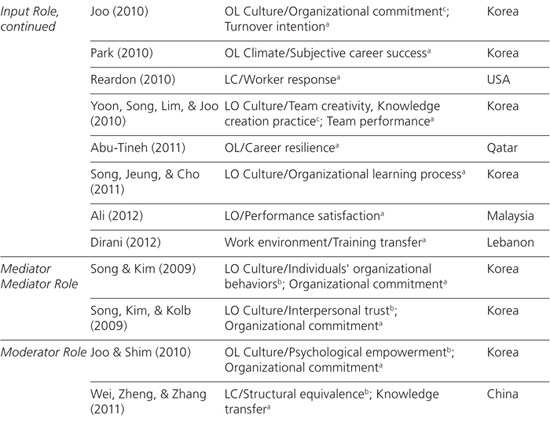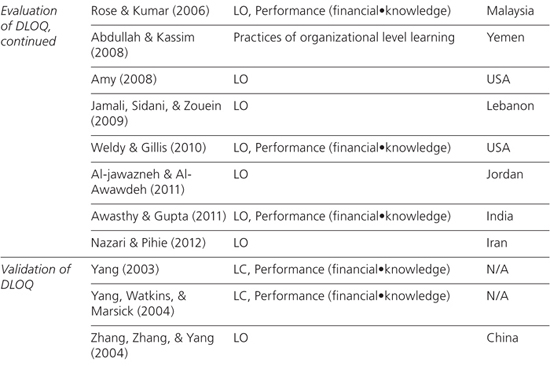9
Case Example: Marsick and Watkins’s Learning Organization Culture Theory
WHILE THE LEARNING ORGANIZATION is a concept that came to the forefront with the publication of The Fifth Discipline (Senge, 1990), the first mention of the term learning organization was in 1979 (Huczynski & Boddy, 1979). Numerous other authors contributed to the literature in this area in the 1990s and developed the concept further (Coopey, 1995; Garvin, 1993; Kim, 1993; Nevis, Dibella, & Gould, 1998; Tsang, 1997; Watkins & Marsick, 1993). This chapter looks at the concept of the learning organization from a theory-building perspective. Only one contribution to the learning organization literature has framed its approach in terms of theory building—Watkins and Marisck’s (1993) book called Sculpting the Learning Organization.
The overarching purpose of this chapter is to provide an example of theory building that has been conducted using a variety of techniques. This chapter applies the method and its phases to profile a theory that began to emerge almost a decade earlier. In this case example, the task is to illustrate each of the five phases applied to Marsick and Watkins’s specific theory of learning organization culture (Watkins & Marsick, 1993, 1996, 2003). This chapter will
• describe the Conceptualize phase as applied to the learning organization,
• look at the Operationalize phase as applied to the learning organization,
• discuss the Apply phase as applied to the learning organization,
• describe the Confirm phase as applied to the learning organization,
• examine the continuous refinement and development of a theory of the learning organization, and
• discuss a set of quality indicators that have been applied to the learning organization theory-building work.
WHAT IS A LEARNING ORGANIZATION?
Learning organization is a term used to describe organizations that have developed ways to promote continuous learning as a part of their unique cultures. Generally, the learning organization functions at two levels: (1) the people level and (2) the systems level (Argyris & Schon, 1974). Various mechanisms can be used to promote learning, such as rigorous innovation programs, investments in research and development, and even performance management. While a variety of authors were working around the same ideas, Senge’s 1990 book, The Fifth Discipline, became widely popular and introduced the concept of the learning organization to many people.
A THEORY OF LEARNING ORGANIZATION DIMENSIONS
Yang, Watkins, and Marsick (2004) described the learning organization as follows:
The construct of the learning organization normally refers to organizations that have displayed these continuous learning and adaptive characteristics, or have worked to instill them. Organizational learning, in contrast, denotes collective learning experiences used to acquire knowledge and develop skills. (p. 34)
Some authors have promoted the need to differentiate learning organizations and organizational learning. The purpose of this chapter is not to engage in a deep discussion of the variations on learning in organizations; however, the differentiation between the two terms deserves some mention. “While organizational learning analyzes learning processes without paying much attention to the outcomes, a learning organization is mainly prescriptive, linking to improvement” (Song, Joo, & Chermack, 2009, p. 47).
The learning organization is more than an organization that promotes learning. Watkins and Marsick (1993) drew from over 30 years of experience working with organizations interested in increasing their capacity to support learning at all levels. The outcome was in the form of a theory of the learning organization, which they have worked to enhance over the last 15 years (Watkins, 2005).
CONCEPTUALIZE PHASE OF LEARNING ORGANIZATION CULTURE THEORY
Again, based on over 30 years of practical experience, initial ideas about learning in organizations began to take shape (Watkins & Marsick, 1993).
Step 1—Defining the Concepts
The authors describe their process as “theory building” (p. 13) that involved extensive literature reviews, case studies, and long-term research projects aimed at action science and action reflection learning (Watkins & Marsick, 1993). Additional efforts sponsored by the American Society for Training & Development “solicited case studies . . . resulting in seventy individual responses and thirty-two submitted cases” (p. 17) of large-scale learning projects across the theorizing. The combination of experience in organizations, deliberate theorizing, literature reviews, and case studies resulted in seven core dimensions of the learning organization that constitute their theory in the Conceptualize phase. The theory is based on seven key constructs shown in Figure 9.1. Each of these constructs has substantive evidence to support a rationale for its inclusion in the theory.
Step 2—Organizing the Concepts
Watkins and Marsick (1993, 1996; Marsick & Watkins, 1999) are not precise about how their seven dimensions became linked or exactly how the relationships among the dimensions can be characterized. However, the authors have clarified that significant effort working in organizations, studying cases, and reviewing relevant literature led to the view that the seven dimensions are interrelated, though they have not specifically described how.
FIGURE 9.1 Watkins and Marsick’s Dimensions of the Learning Organization
Dimension |
Description |
Continuous learning |
Opportunities for ongoing education and growth are provided; learning is designed into work so that people can learn on the job. |
Inquiry and dialogue |
The organizational culture supports questioning, feedback, and experimentation; people gain productive reasoning skills to express their views and the capacity to listen and inquire into the views of others. |
Team learning |
Work is designed to use teams to access different modes of thinking; collaboration is valued by the culture and rewarded; teams are expected to learn by working together. |
Embedded system |
Necessary systems to share learning are created, maintained, and integrated with work; employees are accessible to these high- and low- technology systems. |
Empowerment |
People are involved in setting and implementing a shared vision; responsibility is distributed so that people are motivated to learn toward what they are held accountable to do. |
System connection |
The organization is linked to its communities; people understand the overall environment and use information to adjust work practices; people are helped to see the effect of their work on the entire organization. |
Strategic leadership |
Leadership uses learning strategically for business results; leaders model, champion, and support learning. |
As their work evolved, the seven dimensions became known to characterize learning culture that was eventually positioned as a predictor of firm financial performance (Ellinger, Ellinger, Yang, & Howton, 2002, 2003; Song & Chermack, 2008b), knowledge performance, and behavioral performance.
Step 3—Defining the Boundaries
By definition, the theory was bounded to organization systems—learning organization refers to the organization itself and thus automatically established the boundary of the theory. These are organizations (profit and nonprofit) that exist to perform some function or service and deliver a product or good that is needed. It is quite clear, for example, that Watkins and Marsick did not originally intend for their theory to function at the state, national, or international levels. While the work has evolved over time and has been translated and applied in numerous other languages, the core unit in which the theory is operating is still the organization.
OPERATIONALIZE PHASE OF LEARNING ORGANIZATION CULTURE THEORY
Throughout the 1990s, Watkins and Marsick engaged in a variety of rigorous efforts to clearly and precisely operationalize their thinking about learning organizations. Through a variety of workshops, an idea emerged to create a measurement and diagnosis instrument that would indicate the current state of a learning organization culture.
Step 1—Describe the Propositions
Although they did not explicitly state these propositions, the following propositions are the logical outcomes of the thinking that has led up to this point:
Proposition 1: If continuous learning opportunities are positively associated with learning organization culture, then as continuous learning opportunities increase, learning organization culture improves.
Proposition 2: If dialogue and inquiry are positively associated with learning organization culture, then as dialogue and inquiry increase, learning organization culture improves.
Proposition 3: If collaboration and team learning are positively associated with learning organization culture, then as collaboration and team learning increase, learning organization culture improves.
Proposition 4: If systems to capture and share learning are positively associated with learning organization culture, then as systems to capture and share learning increase, learning organization culture improves.
Proposition 5: If empowering people is positively associated with learning organization culture, then as empowering people increases, learning organization culture improves.
Proposition 6: If connecting the organization to its environment is positively associated with learning organization culture, then as connecting the organization to its environment increases, learning organization culture improves.
Proposition 7: If providing strategic leadership for learning is positively associated with learning organization culture, then as providing strategic leadership for learning increases, learning organization culture improves.
These propositions are the natural, logical outcome of the theorizing done by Watkins and Marsick. Again, these have not explicitly been stated in their work, but it is clear that these assumptions and propositions are foundational to their conceptualization of a learning organization theory. The other main point to add is that Watkins and Marsick specifically oriented their approach based on two levels: (1) the people level of the organization and (2) the system level of the organization. Thus, the propositions could apply to either people or systems, or both.
Step 2—Describe the Results Indicators
This step is where Watkins and Marsick’s work on a theory of learning organizations encountered a barrier. There were no adequate or appropriate measures of learning organization culture that assessed the characteristics they were finding to be so important in successful learning organization cultures. As a result, a large part of their work shifted toward developing an appropriate assessment of learning organization cultures.
Step 3—Develop Research Questions
Logical research questions can be derived from the propositions for the proposed theory of learning organizations. The development of research questions is a relatively simple exercise in the context of the learning organization theory because they are potentially so closely connected to the propositions and results indicators. The research questions that are a natural outcome of the previous steps are the following:
• What are the effects of continuous learning opportunities on learning organization culture?
• What are the effects of dialogue and inquiry on learning organization culture?
• What are the effects of collaboration and team learning on learning organization culture?
• What are the effects of systems that capture or share learning on learning organization culture?
• What are the effects of empowering people on learning organization culture?
• What are the effects of connecting the organization to its environment on learning organization culture?
• What are the effects of strategic leadership for learning on learning organization culture?
As can be expected, these research questions would each logically become the basis for separate inquiry studies. They are also a clear extension of the Conceptualize phase of theory building. The issue for this specific theory-building effort was that measurement and assessment techniques did not exist, so a final research question has become the basis of the learning organization theory evolution:
• Can a comprehensive assessment instrument for learning organization cultures be developed?
This research question has framed the bulk of theory building for Watkins and Marsick. In addition, the results have constituted a major contribution to the theory: research and practice of learning organizations.
CONFIRM PHASE OF LEARNING ORGANIZATION CULTURE THEORY
Once it was clear that the theory of learning organizations had a logical conceptual framework and that the Operationalize phase was somewhat limited due to a lack of available measures, Watkins and Marsick shifted toward developing a specific measure of learning organization cultures. Their goal was to gain “insight into essential steps that will help companies more quickly and successfully move toward their goals” (Marsick & Watkins, 1999, p. 3).
Step 1—Design the Inquiry Study
Beginning with learning-based workshops, Watkins and Marsick realized that an applied measure of learning organization culture did not exist and could be of great value. They started to build a questionnaire around the seven dimensions they had identified as critical to a learning organization culture. Each item on the questionnaire began with the phrase “In my organization . . .” so as to create uniformity among the items, and each was measured on a six-point Likert scale. The questionnaire was reviewed numerous times with experts and students to check for utility, plain language, and basic validity and reliability statistics. This information was used to change or delete weak or poorly worded questions so as to ensure a robust overall questionnaire. The resulting questionnaire was named the Dimensions of Learning Organization Questionnaire (DLOQ).
Step 2—Collect and Analyze Data
Once initial score reliability and validity were established, the researchers began larger, more complex studies that emerged along two strands of research: (1) further, more complex validity studies and (2) a variety of survey-research studies conducted through the authors’ home institutions (the University of Georgia and Columbia University’s Teachers College).
Watkins and Marsick invited Baiyin Yang to join their research team with an explicit goal of continuing to confirm the score reliability and construct validity of the DLOQ. Because of his statistical analysis expertise, Yang led several studies that examined psychometric validity, including the DLOQ’s score, construct, and content validity with large sample sizes. These turned out to be very powerful studies that secured a sense of confidence in the initial theorizing by Watkins and Marsick. The authors have been generous with their questionnaire, offering it for use by theorists and encouraging additional studies that explore its utility as a diagnostic and research tool.
The second stream of research studies that sought to use the DLOQ as a research variable measure was also a productive one. Many authors have positioned the DLOQ as a variable in their own sets of inquiry studies. For example, scenario-planning theory has positioned learning organization culture as an outcome variable of the scenario-planning process.
To summarize, the DLOQ has been of high utility over the past decade. A summary of research studies (both validity and other) is provided in Figure 9.2. These studies illustrate a great interest in learning organizations as a relevant and important variable in organizational research. This entire set of inquiry studies could be thought of as a continued effort in the Operationalize phase of theory building for the theory of learning organization culture.
FIGURE 9.2 Dimensions of Learning Organization Questionnaire Studies
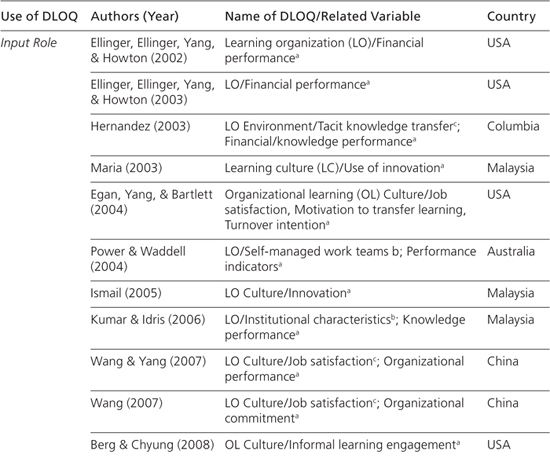
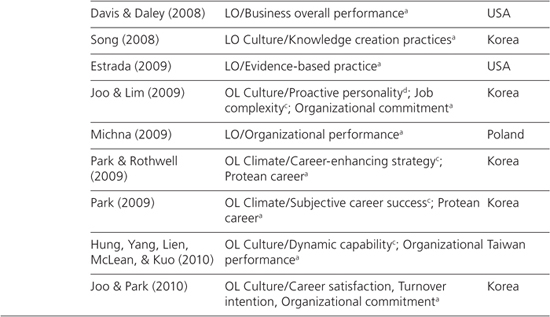
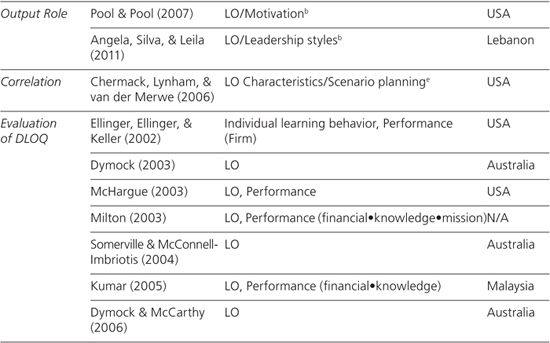
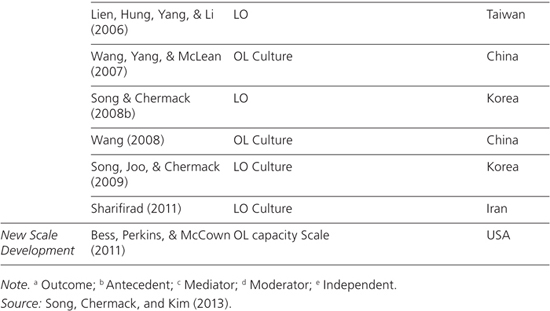
Step 3—Connect the Results to the Theory
The results of the inquiry studies cited in Figure 9.2 have been overwhelmingly supportive of the theory of learning organization culture. Evidence has been collected from a variety of organization types, industries, countries, languages, and locations that confirms the utility of the theory and the accuracy or fit of the authors’ theorizing with reality.
Additionally, an analysis of the variable position of the DLOQ has been conducted (see Figure 9.3). Each of these individual studies (and particularly the validity studies) has made reference to what the results mean for the research and practice of learning organization. In short, efforts to confirm/disconfirm the theory of learning organization have spanned a decade and the collective outcomes confirm the theory in the real world.
APPLY PHASE OF LEARNING ORGANIZATION CULTURE THEORY
The Apply phase was in many ways the starting point for the learning organization culture theory developed by Watkins and Marsick. The issues related to learning organization cultures were a part of their work before the term learning organization was recognized. In addition, Watkins and Marsick have been simultaneously delving into research, theorizing, and practice. The culmination of how to work with the DLOQ and related concepts was published in another book titled Facilitating Learning Organizations (Marsick & Watkins, 1999). This book sought to “offer advice to facilitators and change agents who wish to build systems-level learning in order to create knowledge that can be used to gain a competitive advantage” (p. 4). The book is in many ways a chronicle of the Apply phase.
FIGURE 9.3 Frequency of Dimensions of the Learning Organization and Related Variables
Type |
Variable (Frequency) |
Roles of DLOQ |
Input (28), Mediator (2), Moderator (2), Output (2), Correlation (1) |
Antecedent |
Motivation, Self-managed work teams, Psychological empowerment, Interpersonal trust, Individuals’ organizational behaviors, Structural equivalence, Leadership styles, Institutional characteristics |
Mediator/Moderator |
Job satisfaction (2), Job complexity, Proactive personality, Career-enhancing strategy, Subjective career success, Dynamic capability, Organizational commitment, Team creativity, Knowledge creation practice, Tacit knowledge transfer |
Outcome |
Organizational/Business/Team/Financial performance (9), Organizational commitment (6), Job/career/performance satisfaction (3), Turnover intention (3), Innovation (2), Knowledge/Training transfer (2), Protean career (2), Career resilience, Evidence-based practice, Knowledge creation practices, Motivation to transfer learning, Organizational learning process, Subjective career success |
Note: Frequency in parentheses is shown only when a variable was used more than one time. Each of these individual studies (and particularly the validity studies) has made reference to what the results mean for the research and practice of learning organization. In short, efforts to confirm/disconfirm the theory of learning organization have spanned a decade and the collective outcomes confirm the theory in the real world.
Source: Song, Chermack, and Kim (2013).
Step 1—Analyze Related Problems
Facilitating Learning Organizations is full of examples of application in a variety of companies, from Johnsonville Foods to the Public Service Enterprise Group. It is a set of miniature case studies. In almost every case, the DLOQ is positioned as a diagnostic tool. It is an analysis tool. Using the DLOQ can help to identify problems among its seven dimensions; therefore, it is often used as a starting point for organizational change. Most of the cases document using the DLOQ as an analysis tool and then jumping into a variety of facilitator tips for how to react to various states identified by the DLOQ diagnosis.
Step 2—Propose, Create, and Implement Solutions
The unique thing about the DLOQ is that it can potentially identify and locate the problem area and suggest immediate solutions. For example, if the “dialogue and inquiry” dimension is shown to be lacking, a variety of techniques can be used to promote conversations across the levels of the organization. If the “team learning” dimension returns a low score, a variety of approaches to team building and work design can be implemented. If “connection to the external environment” is shown to be an issue, revised strategy and strategic learning options can be considered. The DLOQ has tremendous utility as a diagnostic tool, and this step is perhaps where it shines in the Apply phase.
Secondary to a diagnostic tool is using the DLOQ as a variable characteristic. For example, a variety of organizational interventions are designed to impact culture. The DLOQ gives other theorists a ready-made, operationalized measure of learning organization characteristics to use. Many of the inquiry studies summarized in Figure 9.2 used the DLOQ in this way; and as such, from an assessment perspective, the DLOQ can be used as an initial measure of learning culture with intent to improve it, or as an initial measure of a variable within another research system.
Step 3—Assess Results
Watkins and Marsick have gone far beyond anecdotes. Results of studies using the DLOQ have been scrutinized in the double-blind, peer review process. Therefore, the results are credible and scholarly. In almost every instance of inquiry, the studies that have focused on the DLOQ have assessed the results in the context of either (1) establishing further validity and reliability of DLOQ scores or (2) addressing practical problems in practice. With the addition of their cases and practical advice for facilitators published in Facilitating the Learning Organization, Watkins and Marsick have led a charge to develop a theory-based approach to learning organizations that has established evidence of confirmation and considerable application.
Refine Phase of Learning Organization Culture Theory
The continuous nature of the approach to developing theory chosen by Watkins and Marsick is admirable and has been consistently multifaceted. In other words, the authors have consistently advanced multiple phases of theory building at the same time. More than many applied theory examples, the learning organization culture theory has consistently developed over time in terms of its utility in research, measureable aspects, and application. In addition, it has gained attention and use across several disciplines, including adult learning, human resource development, and management.
Given that extensive effort has been undertaken to examine the psychometric properties of measurement validity and that reliability has been established, the greatest opportunity for continuous refinement is in the use of learning organization culture as an outcome variable for a variety of possible interventions and more definite application processes. While Facilitating the Learning Organization contains many practitioner tips and advice, it does not provide a guiding framework or process steps (even if generic) for instilling the seven dimensions. There is still room to advance the understanding of “how to” develop a learning organization.
SUMMARY AND STATUS OF LEARNING ORGANIZATION CULTURE THEORY
This chapter has illustrated the phases of theory building using the learning organization culture theory developed by Watkins and Mar-sick (1993; Marsick & Watkins, 1999). Each phase of the theory-building process was described, as well as the major direction of the theory building and potential areas for continued development. Following the same format, the next chapter describes the application of the various phases and steps of this book to the theory of scenario planning created by Chermack (2004, 2005).

